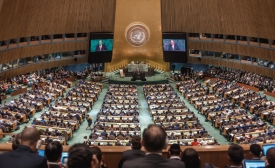kashmir

Tensions between India and Pakistan played a significant role at the latest UN General Assembly, according to Muhammad Ittefaq.
What is life like for a young girl growing up in Indian-administered Kashmir, one of the most heavily militarized zones in the world? How different is it to that of a girl living in the Indian capital Delhi? BBC Hindi's Divya Arya asked two teenagers, Duaa from Srinagar and Saumya in Delhi, to become pen pals.
Indian and Pakistani diplomats tend to agree on one thing: A peace deal with their quarrelsome neighbor will need to be worked out under the cover of darkness through a so-called “back-channel.” [...] The benefits of backroom diplomacy are well known. Keeping negotiation processes outside the public gaze allows parties to make concessions and explore creative proposals that could otherwise mean political suicide for their leaders.
India’s and Turkey’s bilateral relations have been marked by cordiality and warmth since the establishment of their diplomatic relationship in 1948. However, the Pakistan factor has overshadowed Indo-Turkey relations during the last several decades. The bilateral ties between Turkey and Pakistan has been tied and strengthened by their historical and religious legacies.
Signaling a new diplomatic push to refurbish its battered image and win friends and influence nations, Pakistan is sending Maleeha Lodhi, a high-profile envoy, who has asserted that "her prime focus will be creating a clear line on Kashmir cause," to the United Nations.
For a brief moment after Indian Prime Minister Narendra Modi’s election victory, there was optimism in both India and Pakistan. (...)Unfortunately, it has all been downhill since.
The recent violence along the Line of Control (LoC) between India and Pakistan in Kashmir threatens confrontation yet again between the two nuclear armed neighbors. It also underscores the need to rescue the fragile Track II process from irrelevance, because ultimately it is through genuine people-to-people exchange that long-term peace between the two nations is possible.
In this week’s frantic rescue effort, one unexpected development is the army’s use of Twitter, WhatsApp, a messaging service, and Facebook to reach families. Twenty years ago, when social media first emerged, India’s government — like its counterparts in Beijing and Moscow — regarded it warily, as a force that could undermine state power.







